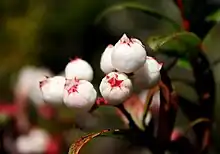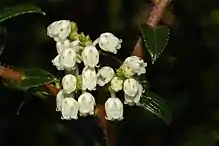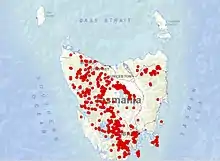Gaultheria hispida
Gaultheria hispida, commonly known as the copperleaf snowberry, is an endemic eudicot of Tasmania, Australia. It is an erect multi-branched shrub, that can be found in wet forests and alpine woodlands. Its berries appear snowy white and leaves are tipped with a copper tinge, hence the common name.[1][2]
| Gaultheria hispida | |
|---|---|
 | |
| Gaultheria hispida, Tasman Peninsula, Tasmania | |
| Scientific classification | |
| Kingdom: | Plantae |
| Clade: | Tracheophytes |
| Clade: | Angiosperms |
| Clade: | Eudicots |
| Clade: | Asterids |
| Order: | Ericales |
| Family: | Ericaceae |
| Genus: | Gaultheria |
| Species: | G. hispida |
| Binomial name | |
| Gaultheria hispida | |
Description

Gaultheria hispida is a small, erect multi-branched shrub in the family Ericaceae. G. hispida can grow up to 2 m (6 ft 7 in) in a protected site, such as a forest, but will be smaller in more exposed alpine sites. Its leaves grow to be 4–9 cm (1.6–3.5 in) long and appear dark green and glossy with depressed veins and finely serrated leaf margins, tinged copper.[1][2] Stems are usually red with terminal clusters of small white, urn-shaped flowers at its apex. The plant flowers in Spring through Summer followed by distinctive snowy white sepals enclosing reddish capsules or "fruit" in Autumn.[1]
It is considered to be highly representative of the family Ericaceae for its phylogenetic significance.[3]
Cultivation
G. hispida can be easily propagated from cuttings or seeds, making it a favourable garden plant. They are best suited to a constantly moist, well-drained site, with loamy and or fertile soils.[1][4]
Habitat and distribution

The genus Gaultheria is found across Australia, New Zealand, Asia, and North and South America. The plant is found exclusively in Tasmania and some parts of Victoria.[1][5] The species is considered endangered within Victoria and of conservation significance in Tasmania but is neither threatened nor uncommon.[6][3] G. hispida is most abundant in cool, moist, mountain or alpine areas, between 250–1,100 m (9,800–43,300 in).[1]
Its distribution is most abundant in the western side of Tasmania, (to the west of Tylers line), on ancient fold province soils, where wet forests and alpine vegetation dominate. Other patches of distribution, to the east of Tyler's line, are predominantly alpine areas, in the northeast, southeast, and central north, on younger fault province soils.[3]
Tasmania's unique geological history of repeated glaciation has enabled many species to expand their geographic range. This glaciation caused the contraction and expansions of alpine zones, thereby dispersing species beyond their initial alpine habitats. Many species then continued to persist in these areas, as is the case with G. hispida.[7]
Other suitable habitats for G. hispida in Tasmania include rainforest, wet eucalypt forest and montane vegetation.[4]
Uses
The fruit of G. hispida are edible and have bitter taste. They were commonly collected by Tasmanian Aboriginal People as bushfood and were eaten by early settlers.[8] Other members of the genus Gaultheria have been used to make teas and jellies, and even claimed to have natural anti-inflammatory properties.[9]
Gallery
 Fruit
Fruit Alpine vegetation in Cradle Mountain National park, where G. hispida is found
Alpine vegetation in Cradle Mountain National park, where G. hispida is found
References
- Howells, Christine; Whiting, Jenny; Roberts, Ricky; Reeves, Frank; Verity, Tayler (2012). Tasmania's Natural Flora. Hobart TAS: Australian Plants Society Tasmania Inc., Hobart Group. p. 167. ISBN 9780909830663.
- Jordan, Greg (2017). "Gaultheria hispida (Ericaceae) 2:417". Key to Tasmanian Diocots. Retrieved 28 February 2018.
- "Species Gaultheria hispida (89-00666)". Natural Values Atlas. Department of Primary Industries, Parks, Water and Environment. 2012. Retrieved 20 February 2018.
- "Hobart Plant Species List" (PDF). Understorey network.org. Natural Resource Management Tasmania, Understory Network. 2007. Retrieved 20 February 2018.
- Ian., Clarke (1987). Name that flower : the identification of flowering plants. Lee, Helen. Carlton, Victoria, Australia: Melbourne University Press. ISBN 978-0522843354. OCLC 17511745.
- "Flora of Victoria". vicflora.rbg.vic.gov.au. Retrieved 2018-02-28.
- Tasmanian native bush : a management handbook. Kirkpatrick, J. B. (James Barrie), Pharo, E. J. Hobart, Tas.: Tasmanian Environment Centre. 1991. ISBN 978-0909160098. OCLC 26756373.
{{cite book}}: CS1 maint: others (link) - Low, Tim (1991). Wild food plants of Australia (Rev. ed.). North Ryde NSW, Australia: Angus of Robertson. ISBN 978-0207169304. OCLC 25220546.
- Zhang, Dan; Liu, Rui; Sun, Lan; Huang, Chao; Wang, Chao; Zhang, Dong-Ming; Zhang, Tian-Tai; Du, Guan-Hua (2011-05-09). "Anti-Inflammatory Activity of Methyl Salicylate Glycosides Isolated from Gaultheria yunnanensis (Franch.) Rehder". Molecules. 16 (5): 3875–3884. doi:10.3390/molecules16053875. PMC 6263312. PMID 21555977.